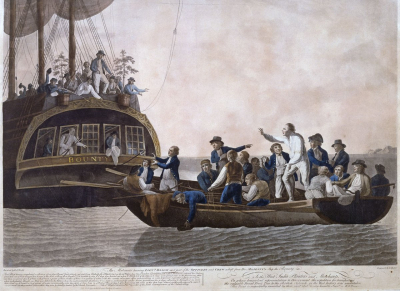HMS Bounty, also known as HM Armed Vessel Bounty, was a small merchant vessel that the Royal Navy purchased in 1787 for a botanical mission. The ship was sent to the South Pacific Ocean under the command of William Bligh to acquire breadfruit plants and transport them to the West Indies. That mission was never completed owing to a 1789 mutiny led by acting lieutenant Fletcher Christian, an incident now popularly known as the mutiny on the Bounty. The mutineers later burned Bounty while she was moored at Pitcairn Island. An American adventurer helped land several remains of Bounty in 1957.
The mutiny on the Royal Navy vessel HMS Bounty occurred in the South Pacific Ocean on 28 April 1789. Disaffected crewmen, led by acting-Lieutenant Fletcher Christian, seized control of the ship from their captain, Lieutenant William Bligh, and set him and eighteen loyalists adrift in the ship's open launch. The mutineers variously settled on Tahiti or on Pitcairn Island. Bligh navigated more than 3,500 nautical miles (6,500 km; 4,000 mi) in the launch to reach safety, and began the process of bringing the mutineers to justice.
Bounty had left England in 1787 on a mission to collect and transport breadfruit plants from Tahiti to the West Indies. A five-month layover in Tahiti, during which many of the men lived ashore and formed relationships with native Polynesians, led many men to be less amenable to military discipline. Relations between Bligh and his crew deteriorated after he began handing out increasingly harsh punishments, criticism, and abuse, Christian being a particular target. After three weeks back at sea, Christian and others forced Bligh from the ship. Twenty-five men remained on board afterwards, including loyalists held against their will and others for whom there was no room in the launch.
After Bligh reached England in April 1790, the Admiralty despatched HMS Pandora to apprehend the mutineers. Fourteen were captured in Tahiti and imprisoned on board Pandora, which then searched without success for Christian's party that had hidden on Pitcairn Island. After turning back towards England, Pandora ran aground on the Great Barrier Reef, with the loss of 31 crew and four prisoners from Bounty. The ten surviving detainees reached England in June 1792 and were court-martialled; four were acquitted, three were pardoned, and three were hanged.
Christian's group remained undiscovered on Pitcairn until 1808, by which time only one mutineer, John Adams, remained alive. Almost all of his fellow mutineers, including Christian, had been killed, either by each other or by their Polynesian companions. No action was taken against Adams; descendants of the mutineers and their Tahitian captives live on Pitcairn into the 21st century.

1789Jun, 14
Mutiny on the Bounty: HMS Bounty mutiny survivors including Captain William Bligh and 18 others reach Timor after a nearly 7,400 km (4,600 mi) journey in an open boat.
Choose Another Date
Events on 1789
- 30Jan
Qing dynasty
Tây Sơn forces emerge victorious against Qing armies and liberate the capital Thăng Long. - 4Mar
United States Bill of Rights
In New York City, the first Congress of the United States meets, putting the United States Constitution into effect. The United States Bill of Rights is written and proposed to Congress. - 8Jun
United States Bill of Rights
James Madison introduces twelve proposed amendments to the United States Constitution in Congress. - 2Oct
United States Bill of Rights
George Washington sends proposed Constitutional amendments (The United States Bill of Rights) to the States for ratification. - 3Oct
Thanksgiving (United States)
George Washington makes the first Thanksgiving Day designated by the national government of the US

 English
English  español
español  français
français  português
português  русский
русский  العربية
العربية  简体中文
简体中文 